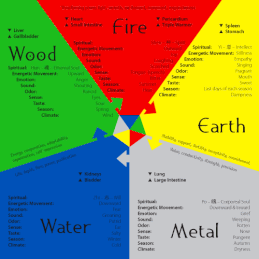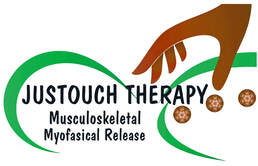FIVE ELEMENTS
The Five Element Theory is the study of relationships in nature. This theory is one of the major systems of thought within Traditional Chinese Medicine. It is used in varying degrees by acupuncturists, and is especially helpful as a guide for balancing our emotions, as well as our physical health. Ancient Chinese healers observed the cyclical patterns in nature, such as the changes of seasons and the cycle of life and death, and applied these patterns to the dynamics of human rhythms. Being in harmony with the universe and with nature is integral to Daoist theory. Each of us is a microcosm of the universe, and our systems follow the same phases that the Chinese found in nature.
The WOOD element is associated with new beginnings and springtime. It corresponds to the Liver and Gall Bladder meridian
systems, the color green, and the emotion of anger.
The FIRE element is associated with growth and summertime. It corresponds to the Heart, Small Intestine, Pericardium, and Triple Warmer meridian systems, the color red, and the emotion of joy.
The EARTH element is associated with balance and transition, such as Indian summer. It corresponds to the Spleen and Stomach meridian systems, the color yellow, and the emotion of worry.
The METAL element is associated with the harvest of the autumn season. It corresponds to the Lung and Large Intestine meridian systems, the color white, and the emotion of grief.
The WATER element is associated with conserving resources and the dormant phase of winter. It corresponds to the Kidney and Bladder meridian systems, the color black/blue, and the emotion of fear.
These ELEMENTS or PHASES are most interesting in the way they work together. They function in a cycle of creation or promotion and a cycle of destruction or control, as shown below. The cycle of creation shows how each element gives birth to the next. Wood builds a fire, fire created the earth, the earth creates metal, metal melts into a liquid like water...and the cycle goes back around as water creates wood (water is needed to grow plants).
The cycle of destruction shows how the elements provide a system of checks and balances for each other. Fire melts metal, metal chops wood, wood displaces earth (like tree roots breaking up the earth), earth channels and dams water, and water puts out fire.
The Five Element Theory was developed into a table of correspondences, as shown below. The entire system is useful in helping us find balance - and balance is health. If an element is overactive or underactive, we can look to the cycles and the other elements to either tone down or strengthen it. For example, if a person has excess fire energy, they may be easily excited (too much joy), tend to "run hot" (feverish or hot flashes), and have heart palpitations. Boosting their water element will help to "put out the fire" by bringing it down to a balanced level. An acupuncturist may use acupuncture and herbs to boost the water element, and a qigong teacher may prescribe specific qigong forms that strengthen water and control fire. Another person may have deficient fire energy, experiencing poor circulation, low self-esteem perhaps from deep psychological trauma. This person would boost their fire by adding more wood.
The WOOD element is associated with new beginnings and springtime. It corresponds to the Liver and Gall Bladder meridian
systems, the color green, and the emotion of anger.
The FIRE element is associated with growth and summertime. It corresponds to the Heart, Small Intestine, Pericardium, and Triple Warmer meridian systems, the color red, and the emotion of joy.
The EARTH element is associated with balance and transition, such as Indian summer. It corresponds to the Spleen and Stomach meridian systems, the color yellow, and the emotion of worry.
The METAL element is associated with the harvest of the autumn season. It corresponds to the Lung and Large Intestine meridian systems, the color white, and the emotion of grief.
The WATER element is associated with conserving resources and the dormant phase of winter. It corresponds to the Kidney and Bladder meridian systems, the color black/blue, and the emotion of fear.
These ELEMENTS or PHASES are most interesting in the way they work together. They function in a cycle of creation or promotion and a cycle of destruction or control, as shown below. The cycle of creation shows how each element gives birth to the next. Wood builds a fire, fire created the earth, the earth creates metal, metal melts into a liquid like water...and the cycle goes back around as water creates wood (water is needed to grow plants).
The cycle of destruction shows how the elements provide a system of checks and balances for each other. Fire melts metal, metal chops wood, wood displaces earth (like tree roots breaking up the earth), earth channels and dams water, and water puts out fire.
The Five Element Theory was developed into a table of correspondences, as shown below. The entire system is useful in helping us find balance - and balance is health. If an element is overactive or underactive, we can look to the cycles and the other elements to either tone down or strengthen it. For example, if a person has excess fire energy, they may be easily excited (too much joy), tend to "run hot" (feverish or hot flashes), and have heart palpitations. Boosting their water element will help to "put out the fire" by bringing it down to a balanced level. An acupuncturist may use acupuncture and herbs to boost the water element, and a qigong teacher may prescribe specific qigong forms that strengthen water and control fire. Another person may have deficient fire energy, experiencing poor circulation, low self-esteem perhaps from deep psychological trauma. This person would boost their fire by adding more wood.




